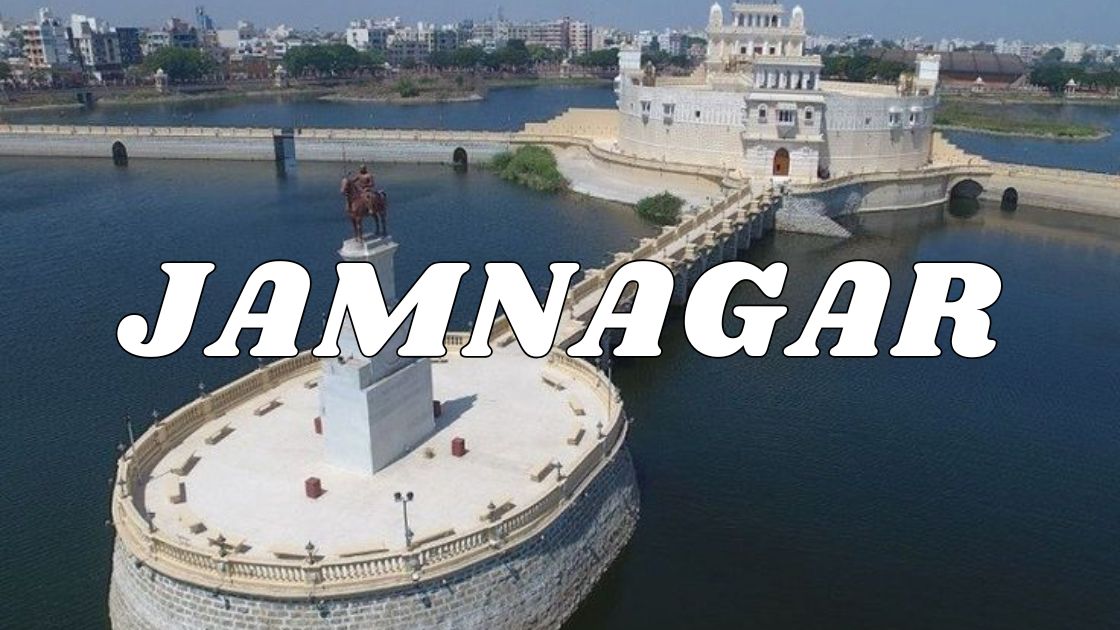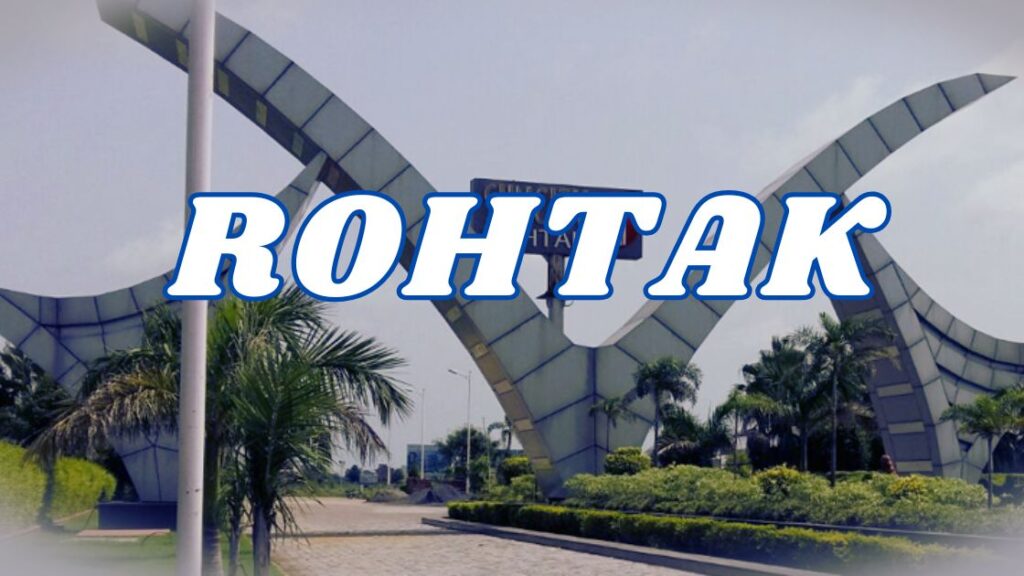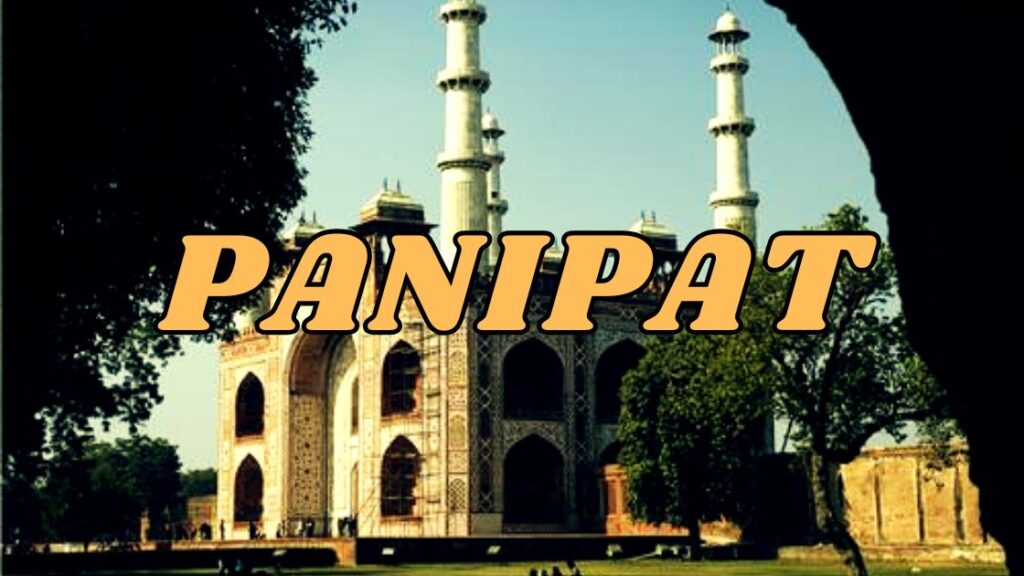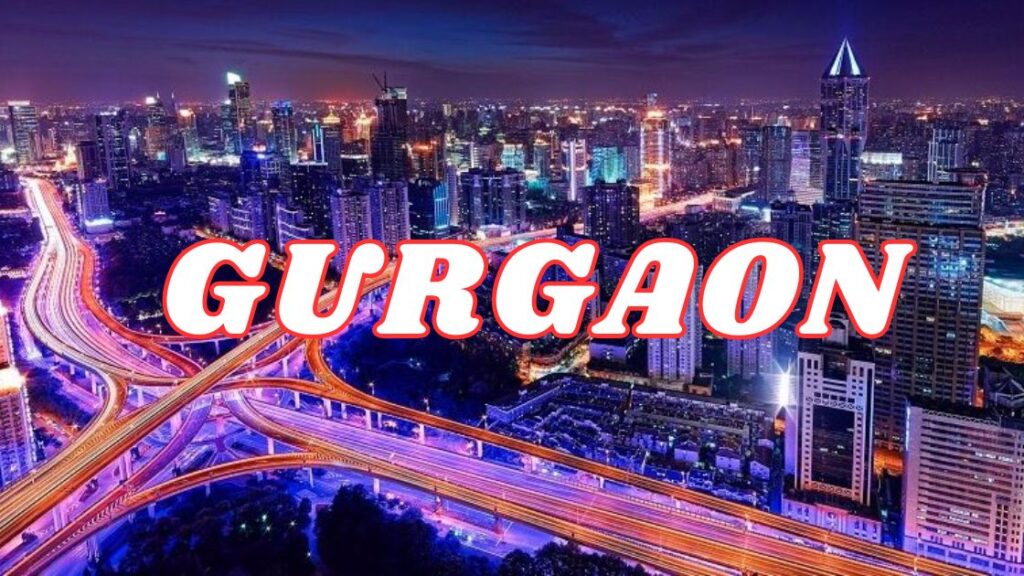Jamnagar, a historic city in the Indian state of Gujarat, serves as the administrative headquarters of Jamnagar district. Situated just south of the Gulf of Kutch, it lies approximately 337 kilometers (209 miles) west of Gandhinagar, the state’s capital. Jamnagar is home to some of India’s most significant industrial projects. Reliance Industries, the country’s largest private company, has established the world’s largest oil refining and petrochemicals complex in the district, reinforcing the city’s status as a major industrial powerhouse.
The city is also witnessing a remarkable transformation in tourism and infrastructure. Reliance Industries is developing the world’s largest zoo, located 28 kilometers from Jamnagar city, further boosting its prominence on the global map. Additionally, Lemon Tree Hotels, a well-known luxury hotel chain, is set to open a high-end property in Jamnagar by FY25.
Jamnagar – A Thriving Industrial Hub with Rich Heritage
Jamnagar holds a rich historical legacy as the former capital of the Navanagar princely state during British rule. The city’s heritage is deeply intertwined with its royal past, reflected in its architecture, traditions, and cultural institutions. In a groundbreaking initiative, the World Health Organization (WHO) and the Government of India have partnered to establish the WHO Global Centre for Traditional Medicine in Jamnagar. With a $250 million investment from the Indian government, this center aims to integrate traditional medicine with modern science and technology, fostering innovation in healthcare for both people and the planet.
Jamnagar is undergoing rapid urban development, with significant projects shaping its future. The Jamnagar Municipal Corporation has announced an ambitious plan to develop a riverfront along the Rangamati and Nagpati rivers, with an estimated cost of ₹500 crores. This initiative aims to enhance the city’s aesthetic appeal, improve infrastructure, and provide recreational spaces for residents and tourists alike.
With its thriving industrial sector, rich heritage, global recognition in traditional medicine, and rapid urban transformation, Jamnagar stands as one of Gujarat’s most dynamic and evolving cities.
History of Jamnagar
Jamnagar, historically known as Navanagar, was established in 1540 by Jam Rawal as the capital of the eponymous princely state. Situated in the Saurashtra region, it emerged as one of the most significant and expansive princely states under the Jadeja dynasty, recognized for its thirteen-gun salute status.
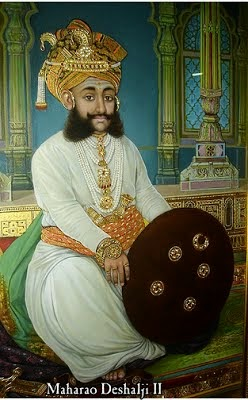
Historical records indicate that Bahadur Shah, the Sultan of Gujarat, granted Jam Lakhaji twelve villages in appreciation of his role in the siege of Pawagadh. Following this acquisition, Jam Lakhaji was assassinated by his cousins, Tamachi Deda and Jam Hamir Jadeja. In retaliation, his son, Jam Rawal, avenged his father’s death by killing the perpetrators and assumed control over Kutch, which maintained semi-independence from the Gujarat Sultanate.
The sons of Hamirji, Khengarji and Sahibji, later served the Sultan of Gujarat. During a hunting expedition, they saved the Sultan from a lion attack. As a reward, the Sultan provided them with military support to reclaim their kingdom. Anticipating their return with the imperial army, Jam Rawal prepared for confrontation.
According to legend, Goddess Ashapura, the principal deity of the Jadeja Rajputs, appeared to Jam Rawal in a dream, admonishing him for breaking an oath taken in her name by killing Hamirji. She instructed him to leave Kutch. Obeying the divine message, Jam Rawal departed from Kutch, and during his journey, he eliminated Tamachi Deda, the main conspirator in his father’s murder. He also conquered Amran and its surrounding areas, appointing his younger brother, Hardholji, as the ruler of Dhrol province. After Hardholji’s death in battle near Khambhalia, his eldest son, Jasoji, succeeded him. Jam Rawal expanded his territory in Saurashtra, establishing a kingdom comprising 999 villages, collectively known as Halar.
While hunting in the area now known as Jamnagar, Jam Rawal observed a hare bravely confronting his hunting dogs. Impressed by the courage of the local wildlife, he believed the inhabitants of this land would possess exceptional valor. Consequently, he decided to establish his capital there. On the seventh day of the bright half of the month of Shrawan, V.S.1956 (August 1540), on the banks of the Rangmati and Nagmati rivers, Jam Rawal laid the foundation of his new capital, naming it Nawanagar (“new town”). Over time, the name evolved to Jamnagar, meaning the Town of the Jams.
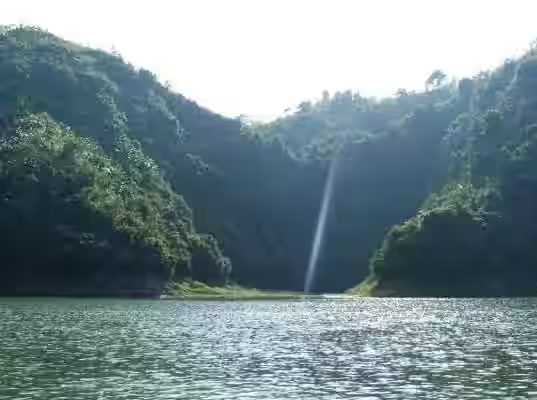
In the 18th century, Nawanagar was governed by the Jadeja Rajputs, renowned for their bravery and military skills. They engaged in numerous battles with neighboring states and played a crucial role in defending the region against foreign invasions.
By 1807, Nawanagar became a princely state under British suzerainty. The first ruler under this arrangement, Maharaja Ranjit Singhji, was noted for his progressive policies and efforts to modernize the state. He established schools, hospitals, and other public facilities, implementing reforms to enhance the well-being of his subjects.
In the 1920s, Jam Saheb Shri Ranjitsinhji was instrumental in developing the city’s modern infrastructure. His successor, Jam Saheb Shri Digvijay Singhji Ranjitsinhji, further expanded the city’s development in the 1940s, during the era of the Princely State of Nawanagar.
This rich history underscores Jamnagar’s transformation from a princely state to a modern city, reflecting its resilience and adaptability through the centuries.
Geography of Jamnagar
Jamnagar is home to diverse communities, including the Jadeja, Khavas Rajput, Charan (Gadhvi), Satvaras (Dalvadis), Ahirs Sagars, Patels, Bhanushalis, Rajputs, Mers, Jains, Lohanas, Brahmins, Bhoi (Bhoiraj), and Vaghers (both Muslim and Hindu). These communities have contributed significantly to the cultural and social fabric of the region.
Ports and Maritime Importance
Jamnagar is strategically located near two significant ports: Rozi Port and Bedi Port. Rozi Port is situated along the Gulf of Kutch, while Bedi Port, an all-weather intermediate seaport, is located 4 km (2.5 mi) inland on the Rangamati River. Bedi Port plays a crucial role in regional trade, exporting commodities such as bauxite, soya meal extracts, and groundnut extracts, while also handling imports of coal, fertilizers, and various industrial goods.
Marine National Park and Pirotan Island
The Marine National Park off the coast of Jamnagar is a unique ecological zone, consisting of 42 coral reef islands. Among them, Pirotan Island, located 12 nautical miles from the shore, is one of the most prominent. This island, covering an area of 3 square kilometers (1.2 sq mi), is known for its coral reefs, mangroves, and diverse marine life, making it a haven for nature enthusiasts and marine biologists.
Khijadia Bird Sanctuary
Situated 10 km (6.2 mi) northeast of Jamnagar, the Khijadia Bird Sanctuary was established on 6 November 1982. It features a seasonal freshwater shallow lake, inter-tidal mudflats, creeks, saltpans, saline land, and mangrove scrub. The sanctuary serves as a breeding ground for birds such as the Great Crested Grebe, Little Grebe, Purple Moorhen, Coot, Black-winged Stilt, and Pheasant-tailed Jacana. Additionally, it provides a habitat for raptors, including Harriers, Eagles, Hawks, and Falcons, as well as migratory birds like Swallows, Martins, Wagtails, and Waterfowl.
Natural Resources
Jamnagar is rich in mineral resources, particularly bauxite, which is extensively mined in the region. The district contributes nearly 95% of the total bauxite production in Gujarat, making it a significant hub for aluminum-related industries.
Climate of Jamnagar
Jamnagar experiences a hot semi-arid climate (Koppen: BSh), characterized by three distinct seasons: summer, monsoon, and winter. The climate is generally hot and dry, with extreme temperatures in the summer and erratic monsoonal rainfall.
Summer (March to May)
The summer season in Jamnagar is intensely hot and humid, with temperatures frequently exceeding 35°C (95°F). The hottest months are April and May, when daytime temperatures can soar up to 47°C (116.6°F), as recorded on May 5, 1990. Humidity levels remain high, making the heat even more oppressive.
Monsoon (June to September)
The monsoon season brings highly unpredictable rainfall, averaging 500 mm (20 in) annually. However, rainfall patterns fluctuate significantly, ranging from less than 100 mm (3.9 in) in 1911 and 1939 to over 1,500 mm (59.1 in) in 2010. The region is occasionally affected by tropical cyclones, which can bring heavy downpours and strong winds. The wettest months are July and August, receiving the bulk of the annual precipitation.
Winter (October to February)
Winters in Jamnagar are mild and pleasant, with warm days and cool nights. The coldest month is January, with minimum temperatures dropping as low as 1°C (33.8°F), recorded on February 5, 1984. Humidity levels are low, and rainfall is almost negligible during this season.
Temperature and Rainfall Statistics
- Hottest temperature recorded: 47°C (116.6°F) on May 5, 1990
- Coldest temperature recorded: 1°C (33.8°F) on February 5, 1984
- Average annual precipitation: 487 mm (19.1 in)
- Wettest months: July and August
- Driest months: March and April, with almost zero rainfall
Jamnagar’s semi-arid climate plays a crucial role in shaping its agriculture, water resources, and lifestyle, making it one of the warmest regions in Gujarat.
Demographics of Jamnagar
Jamnagar’s urban area had a population of approximately 6,68,000 in 2023. The city’s literacy rate is 82.14%, which is higher than the national average of 74.04%. Among the literate population:
- Male literacy rate: 86.90%
- Female literacy rate: 77.05%
Children under six years of age make up 10% of the total population. The male-to-female ratio is 53% males and 47% females.
The Jamnagar Area Development Authority (JADA) is responsible for urban planning and infrastructure development.
Language and Ethnic Composition
- The majority of residents in Jamnagar speak Gujarati as their primary language.
- Kutchi, a distinct language written in the Gujarati script, is spoken by a small percentage of the population. However, it is not mutually intelligible with Gujarati.
- Kathia wadi, a dialect of Gujarati, is commonly used in daily conversations.
Religious Demographics (Historical Perspective – 1901)
Jamnagar, formerly known as Nawanagar, had a diverse religious composition in 1901:
- Hinduism: 59.44% (32,005 people)
- Islam: 31.62% (17,027 people)
- Jainism: 7.49% (4,031 people)
- Zoroastrianism: 0.21% (111 people)
- Christianity: 0.15% (79 people)
- Judaism: 1 person
Today, the city’s religious and cultural diversity remains strong, with Hindus, Muslims, Jains, and other communities coexisting and contributing to the city’s rich heritage and traditions.
Economy of Jamnagar
Jamnagar’s economy has undergone significant transformation due to industrialization and the establishment of major corporations. While traditional industries like Bandhani cloth production continue to contribute to the local economy, with approximately 10% of the population engaged in its production and export, the city has diversified into other sectors.
Historically recognized as the “Brass City”, Jamnagar hosts over 5,000 large-scale and 10,000 small-scale workshops manufacturing brass items, particularly in industrial estates such as Shankar Tekri, GIDC Phase-III, M P Shah Udyognagar, and Dared GIDC-II. These workshops produce brass parts and extruded rods primarily for export, establishing Jamnagar as India’s largest producer of brass items.

In recent years, Jamnagar has earned the moniker “World’s Oil City” due to its substantial oil refining operations. The Jamnagar Refinery, owned by Reliance Industries Limited, is the largest refinery globally, significantly contributing to the city’s economic landscape.
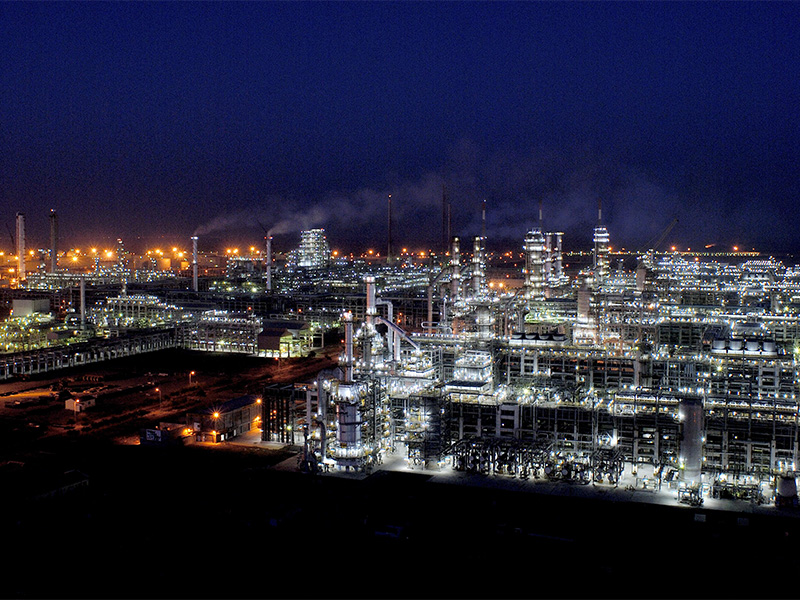
Further diversifying its industrial base, Reliance Industries, under the leadership of Mukesh Ambani, has announced plans to construct the world’s largest data center in Jamnagar. This facility is projected to have a capacity of 3 gigawatts, tripling India’s current data center capacity and marking a significant shift towards technology and data-driven industries in the region.
Additionally, Jamnagar is home to base stations for the Indian Air Force, Army, and Navy, owing to its strategic location near Pakistan. The city also boasts substantial bauxite reserves, with local mines contributing 95% of Gujarat’s total production, further bolstering its economic significance.
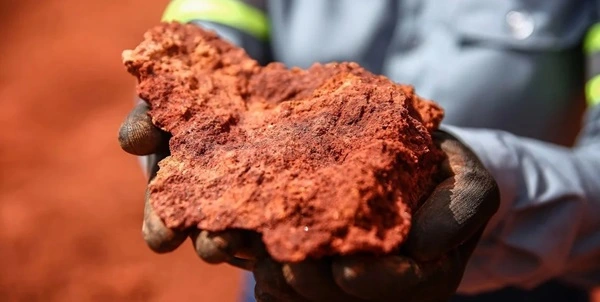
Arts and Culture
Religion in Jamnagar is diverse, with 77.59% of the population adhering to Hinduism, 18.99% practicing Islam, and smaller communities of Jainism (2.51%) and other religions (0.91%). The city is home to a rich array of religious sites, including prominent Hindu temples such as, Badri Kedar Nath, Nilkanth Mahadev Temple, and Bhid Bhanjan Mahadev Temple, with the famous Kashi Vishwanath Temple located on K.V. Road. Jamnagar is particularly known for its four marble Jain temples: Vardhman Shah’s Temple, Raisi Shah’s Temple, Sheth’s Temple, and Vasupujya Swami’s Temple, all dating back to between 1574 and 1622.
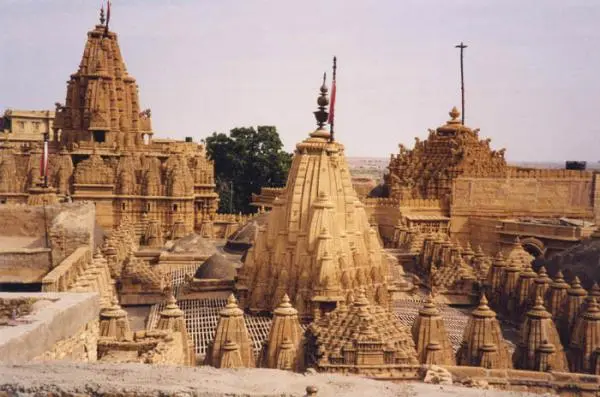
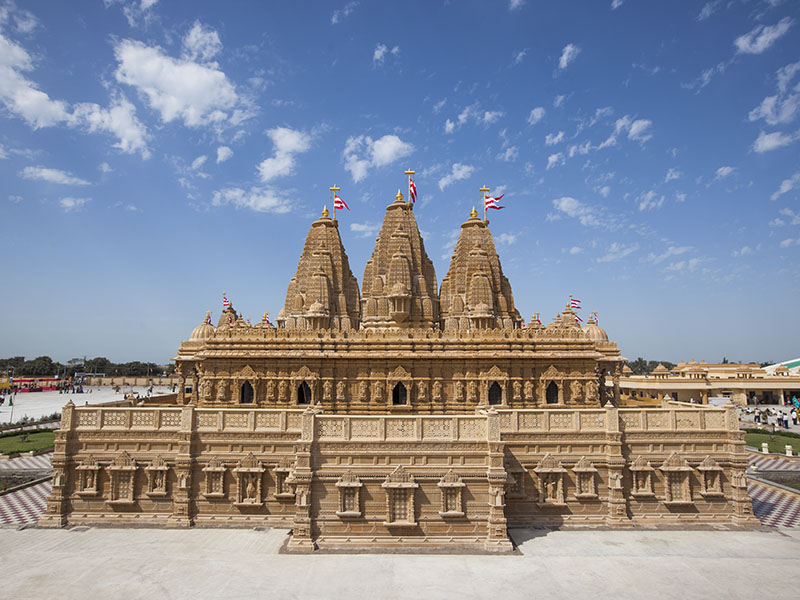
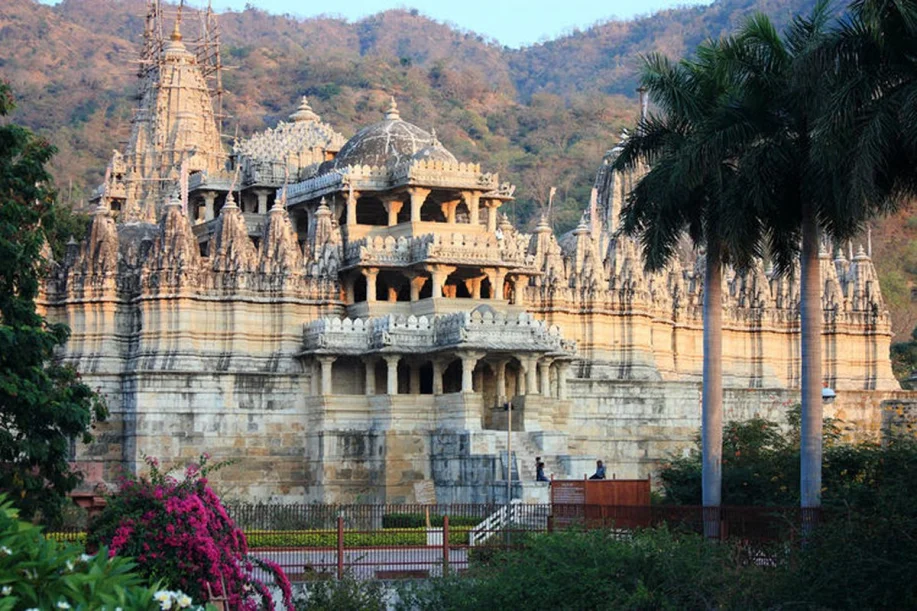
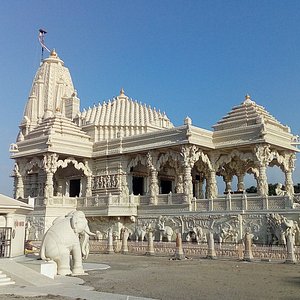
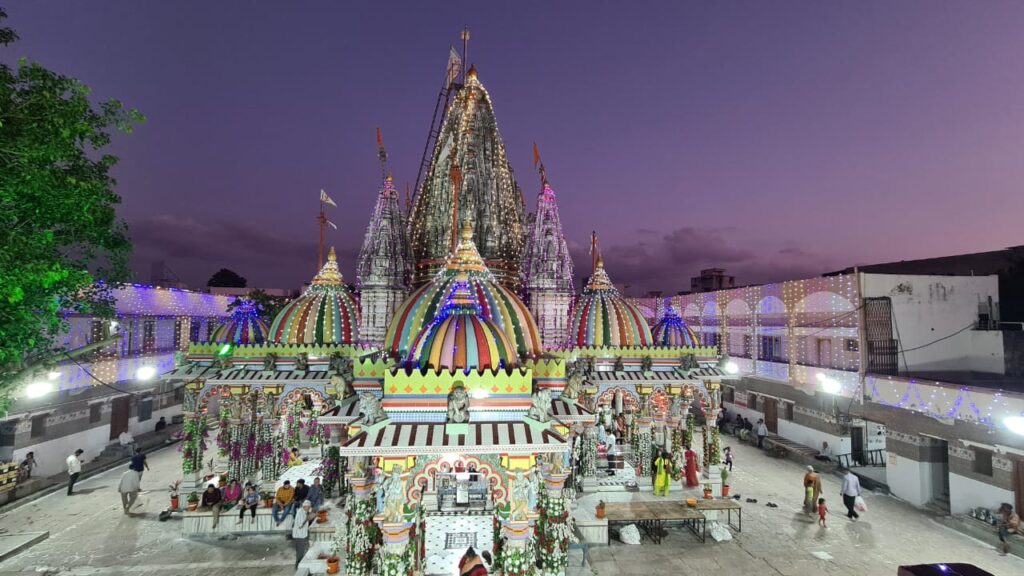
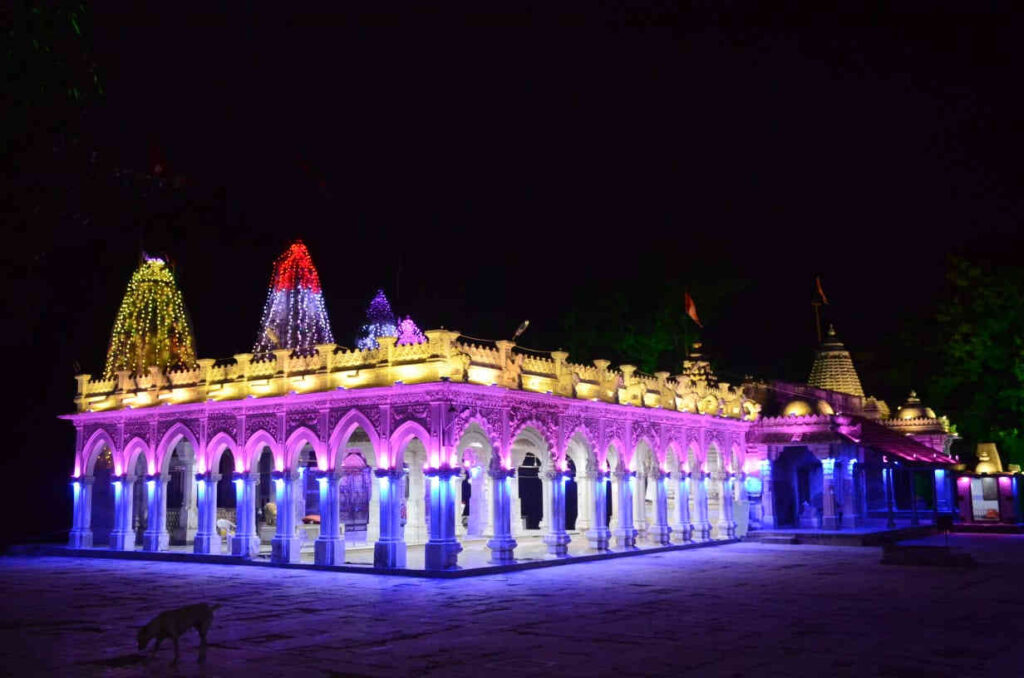
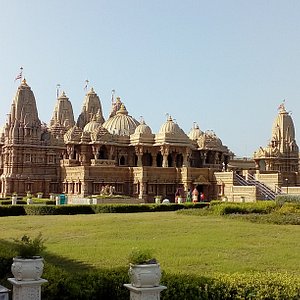
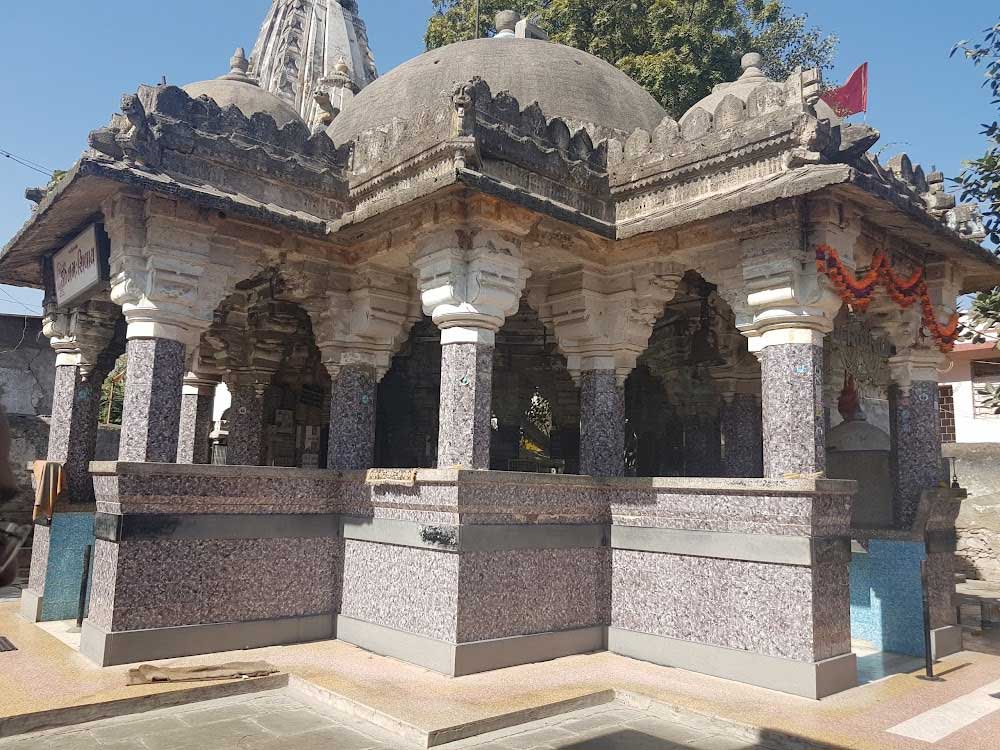
These temples, along with over 30 Jain temples in the region, highlight the city’s historical religious significance. Additionally, the Bala Hanuman Temple is renowned for its continuous chanting of the mantra “Sri Ram, Jai Ram, Jai Jai Ram,” a practice that has earned it a spot in the Guinness Book of World Records. Thousands of devotees visit the temple annually. Other notable festivals and fairs include those held at the Bholeshwar Mahadev Temple and the Bohra Hajira.
Architecture in Jamnagar reflects its historical and cultural richness. The Bohra Hajira, a white marble mausoleum built in 1540 by Jam Rawal, is a significant example of Saracenic architecture, with intricate carvings and situated on the banks of the Nagmati and Rangmati Rivers. Another architectural gem is the Jamnagar Trimandir, a two-storey structure featuring a large hall and a temple. The Khambhaliya Gate, built in the 17th century, is one of two remaining city gates from that era, a testament to Jamnagar’s historical fortifications.
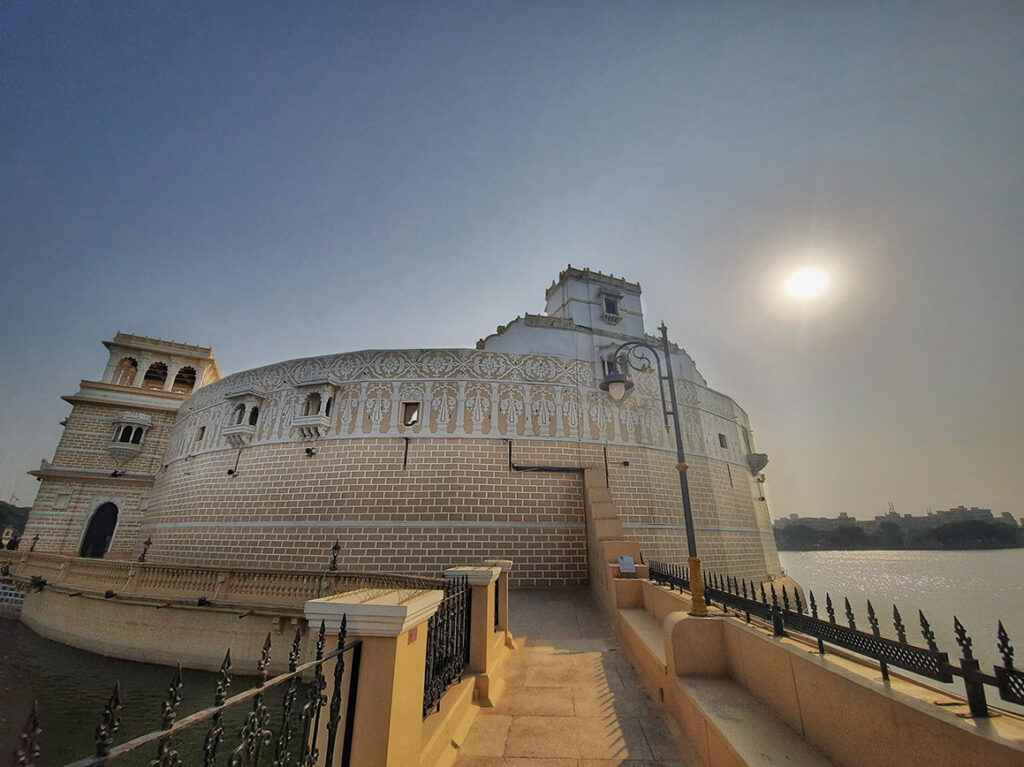
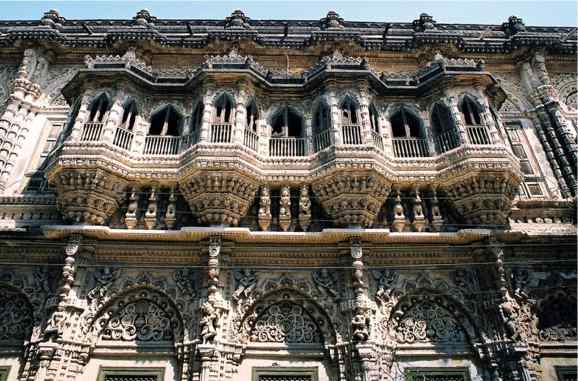
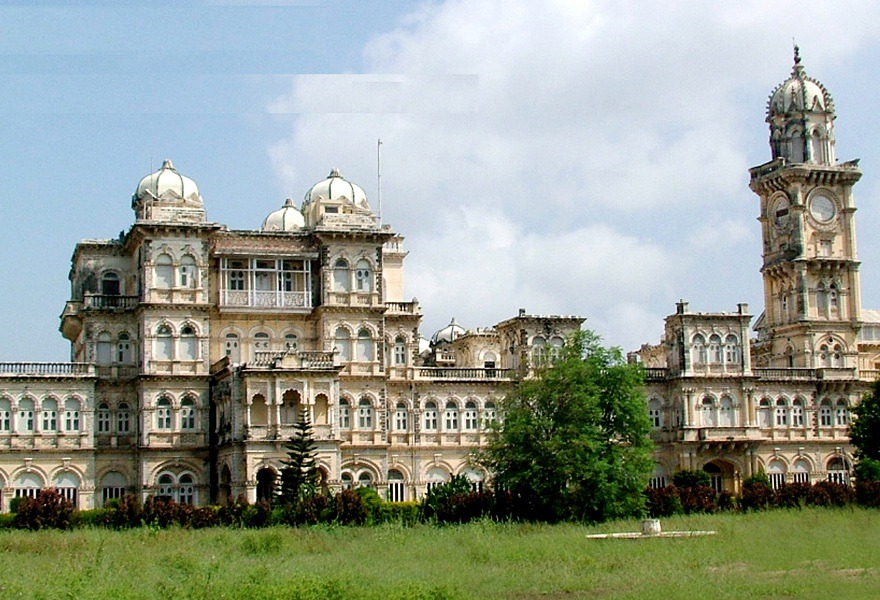
The Pratap Vilas Palace, built during the rule of Ranjitsinhji, showcases a fusion of European architectural style with Indian carvings. The palace, inspired by the Victoria Memorial in Calcutta, features domes in the Indian architectural tradition and columns adorned with carvings of nature and animals. Though the 2001 earthquake caused some damage to the palace and surrounding areas, it remains a significant landmark. Additionally, Willingdon Crescent (now known as Darbargarh Market) was developed by Ranjit Singh to replace a slum area, reflecting his European influences. The crescent’s cusped arches and pilasters make it a notable example of Jamnagar’s urban development.
Sports of Jamnagar
Cricket holds a special place in Jamnagar’s sporting culture, with several prominent Indian Test cricketers hailing from the city. Notable players such as Vinoo Mankad, Indrajitsinhji, Ajay Jadeja, and Ravindra Jadeja have contributed to the city’s rich cricketing legacy. In 1908, HH Shri Jam Ranjitsinhji constructed the Ranjitsinhji Pavilion cricket ground, further cementing Jamnagar’s association with the sport. The Ranji Trophy and Duleep Trophy, two prestigious Indian cricket competitions, were also named in memory of the princes of Jamnagar, honoring their contributions to the game.

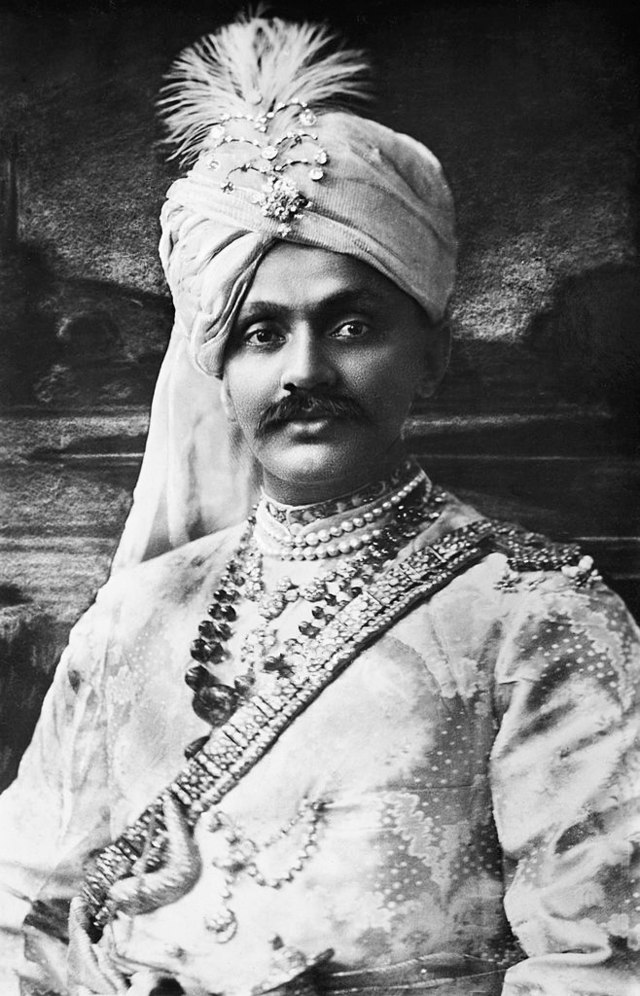
The city’s sports infrastructure includes a sports complex built by the municipal corporation, featuring a swimming pool, badminton court, and various other facilities. Additionally, the Summair Sports Club, established over 80 years ago by the erstwhile rulers of Jamnagar, remains a key sports venue. It offers a range of recreational activities, including a swimming pool, tennis, squash, and badminton courts, along with a billiard hall, table tennis facilities, and a hotel, making it a hub for sports enthusiasts in the region.
Parks and recreation
Jamnagar offers a variety of parks and recreational spaces, making it a vibrant destination for nature lovers and history enthusiasts alike. The Kotha Bastion Museum is a notable site, featuring an intriguing collection that includes sculptures, coins, inscriptions, copper plates, and even the skeleton of a whale. Additionally, the museum has a unique feature—a centuries-old well, where water is drawn by blowing into a small hole in the floor, adding to the charm of the experience.
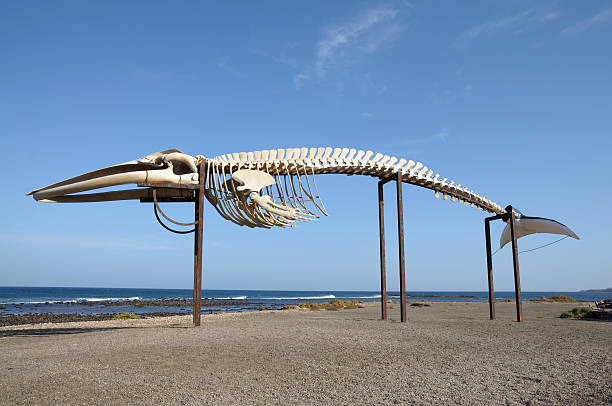
Another significant cultural attraction is the Lakhotia Museum, housed in the former Lakhotia Palace. This small yet fascinating museum showcases a range of items, including sculptures from the 9th to 18th centuries, antique weapons, and pottery unearthed from medieval villages surrounding the area.
For nature enthusiasts, the Marine National Park located on the Gulf of Kutch holds particular significance as India’s first marine sanctuary. About 7 kilometers from the city center, the park is home to an archipelago of 42 islands and is renowned for its coral reefs and mangroves. This area attracts diverse wildlife, including birds, dolphins, finless porpoises, sea turtles, and a variety of tropical fish, offering a serene escape for those seeking to connect with nature.
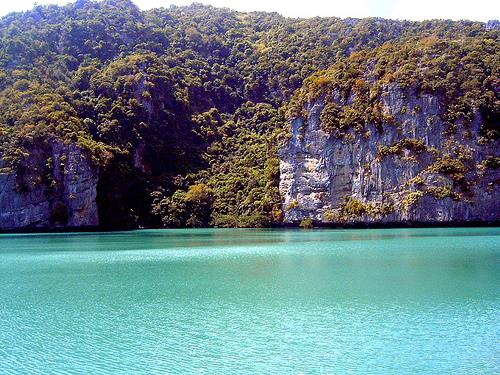
Education system of Jamnagar
Jamnagar is home to a diverse range of educational institutions, both private and government granted. Some of the prominent schools in the city include Jawahar Navodaya Vidyalaya, Poddar International School, and St. Xavier’s High School, offering quality education across different academic levels.
In addition to schools, Jamnagar is known for its higher education institutions in fields such as medicine, dentistry, and health sciences. Notable among these are M. P. Shah Medical College and Gujarat Ayur-Ved University, both of which contribute to the city’s reputation in the medical and healthcare sectors.
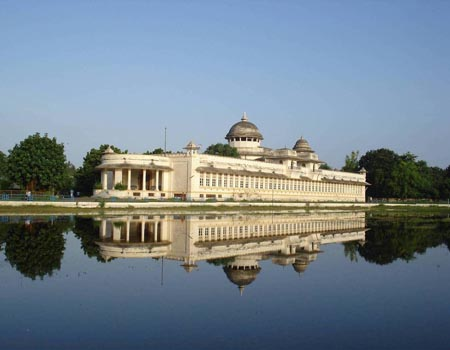
The city also has several colleges offering courses in arts, commerce, and science, providing a well-rounded education system to cater to various academic interests and career paths. These institutions make Jamnagar a growing hub for educational opportunities in the region.
Infrastructure
Jamnagar’s infrastructure is continuously improving to support its growing population and economy. The Amritsar–Jamnagar Expressway (NH-754), currently under construction, is a 1,257 km long, 6-lane wide expressway that will drastically reduce travel time between Amritsar and Jamnagar, from 26 hours to just 13 hours. This expressway will connect four states—Punjab, Haryana, Rajasthan, and Gujarat—and play a strategic role in linking oil refineries in the region, including HMEL Bathinda, HPCL Barmer, and Reliance Industries Limited (RIL) Jamnagar. Expected to be completed by September 2023, the expressway is part of the Bhavatmaja project and the Amritsar–Jamnagar Economic Corridor, enhancing connectivity for both industrial and logistical purposes.
The transportation system within the city is well-established, with private bus services connecting Jamnagar to cities like Ahmedabad, Mumbai, Pune, and Vadodara, among others. The state transport system ensures connectivity to nearly all cities in Gujarat, along with interstate bus facilities. Local buses are operated by the Jamnagar Municipal Corporation, while Ola Cabs and auto rickshaws offer more personal transportation options.
Jamnagar Railway Station is an important hub, offering daily train services to Mumbai and weekly trains to major cities across India. Additionally, the city is served by an airport with direct flights to Mumbai, and thrice-weekly flights to Hyderabad and Bengaluru. This connectivity significantly supports both the local economy and tourism.
In terms of utilities, Sikka Thermal Power Station, a coal-fired power station, serves as a major source of power for Jamnagar. The city is well-equipped with modern cable operators, including GTPL, as well as DTH services from major providers like Tata Play, Airtel, Dish TV, and Videocon D2H. BSNL offers broadband services, and Reliance Jio provides 4G services. Mobile network coverage is widespread, with all major operators, including Vi, Airtel, and BSNL, available in the city.
This robust infrastructure supports the continued growth of Jamnagar, ensuring it remains a key industrial, transportation, and cultural hub in Gujarat.
Media
Jamnagar has a vibrant media landscape, with both local and national outlets serving the city’s residents. All India Radio broadcasts on 100.1 MHz, while Top FM can be heard on 91.9 MHz and Radio Mirchi on 95 MHz These stations provide a mix of news, music, and entertainment, catering to various tastes and preferences.
In terms of print media, Jamnagar has a strong presence of daily newspapers in multiple languages. National newspapers like The Times of India, Economic Times, Indian Express, and Business Standard are widely available, keeping residents informed on current affairs, business, and global news.
For local news, several Gujarati newspapers such as Aajkaal, Bhoomi, Jamnagar Bhaskar, Khabar Gujarat, Lokwat, and Nobat serve the community, covering everything from local politics and cultural events to lifestyle and entertainment. The Princely State is the prominent English-language newspaper in Jamnagar, providing English-speaking residents with comprehensive news coverage.
Notable Personalities
This media diversity ensures that Jamnagar’s population has access to a wide range of information, both from a local and global perspective.
Jamnagar has been home to several notable personalities who have made significant contributions to various fields, particularly in sports, literature, and entertainment.
- Ranjitsinhji, the former King of Jamnagar and an iconic cricketer, is renowned as one of India’s first international cricketers. He represented the England cricket team during the early 20th century and played a pivotal role in promoting the sport in India.
- Ruskin Bond, the beloved author, is another famous figure from Jamnagar. He is known for his works on nature, childhood, and life in the hills, especially for his books for children and his deep connection with the natural world.
- Vinoo Mankad, a celebrated former cricketer, was known for his all-round skills and played an important role in India’s cricket history.
- Duleepsinhji, a former cricketer, also hailed from Jamnagar and made contributions to the Indian cricket team in the early 20th century.
- Salim Durani, an Indian former Test cricketer, was famous for his all-rounder skills and for being a crowd favorite with his charismatic personality.
- Remo D’Souza, the dancer, choreographer, actor, and film director, has contributed significantly to the Bollywood industry, particularly in the field of dance and choreography.
- Indrajitsinhji, a former Test cricketer, and Ajay Jadeja, a former ODI cricketer, both have represented India on the international cricket scene and are remembered for their contributions to Indian cricket.
- Rajendrasinhji Jadeja, the first Chief of Army Staff of India, served in the Indian Army and played a significant role in the country’s military leadership.
- Ravindra Jadeja, one of the most prominent names in contemporary Indian cricket, has earned accolades for his performance as an all-rounder for the Indian team.
- Digvijaysinhji Ranjitsinhji, known as the Jam Sahib of Nawanagar, was referred to as The Good Maharaja for his humanitarian work and leadership in the region.
These individuals have helped shape Jamnagar’s rich history, contributing to its legacy in sports, literature, entertainment, and public service.

